Georgia, like many states, faces challenges when it comes to crime in certain areas. Some cities consistently report higher crime rates, making them statistically more dangerous than others.
Focusing on factors such as violent crime, property crime, and overall safety, the data reveals a handful of cities that stand out for their elevated risk levels.
College Park is considered to be one of the most dangerous cities in the state, but cities like Forest Park and Atlanta are not lagging too far behind.
Currently, Georgia’s crime rate is at 20.58, and it is home to some of the most dangerous cities in America.
In this analysis, we’ll examine the most dangerous cities in Georgia based on recent crime statistics and what they indicate about the broader social and economic issues at play.
| Rank | City | Population | Violent Crimes | Property Crimes | Total Crimes | Chances of Becoming a Victim |
|---|---|---|---|---|---|---|
| 10 | Statesboro | 34,353 | 114 | 869 | 983 | 1 in 301 |
| 9 | Hinesville | 35,441 | 220 | 939 | 1,159 | 1 in 161 |
| 8 | Warner Robins | 82,175 | 591 | 3,015 | 3,606 | 1 in 139 |
| 7 | Atlanta | 499,127 | 4,312 | 19,600 | 23,912 | 1 in 116 |
| 6 | LaGrange | 31,773 | 211 | 1,404 | 1,615 | 1 in 151 |
| 5 | Douglasville | 37,948 | 239 | 1,835 | 2,074 | 1 in 159 |
| 4 | Rome | 37,913 | 376 | 1,776 | 2,152 | 1 in 101 |
| 3 | Milledgeville | 16,837 | 146 | 811 | 957 | 1 in 115 |
| 2 | Forest Park | 19,400 | 177 | 947 | 1,124 | 1 in 110 |
| 1 | College Park | 13,914 | 218 | 1,005 | 1,223 | 1 in 64 |
Table of Contents
Toggle10. Statesboro – 28.61 per 1000 People
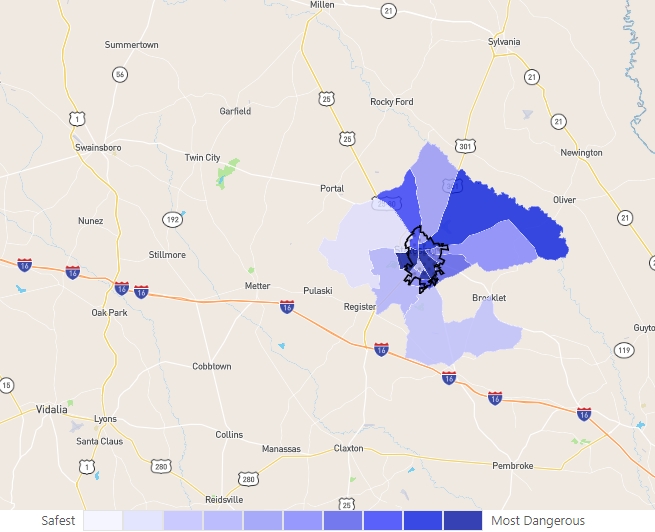
Statesboro, a city with a population of 33,185, faces significant challenges with crime, particularly violent crime. It is ranked at the tenth place in our list of most dangerous cities in Georgia.
The violent crime rate in Statesboro is 3.32 per 1,000 residents, while the total crime rate reaches 28.61 per 1,000.
- Population: 33,185
- Violent Crimes: 114
- Property Crimes: 869
- Total Crimes: 983
- Chances of Becoming a Victim: 1 in 301
These figures are considerably higher than many other communities of similar size, highlighting a pressing concern for local authorities and residents alike.
The presence of Georgia Southern University within Statesboro adds a layer of complexity to the city’s demographic composition and crime dynamics.
The university attracts a large number of young adults, around 20,000 of them, according to Georgia Southern University, and influences various aspects of city life, from economics to cultural activities.
The influx of students also impacts local law enforcement strategies and crime patterns, sometimes intensifying challenges related to crime.
Notably, certain neighborhoods in Statesboro, which have a massive say in making it one of the most dangerous cities in Georgia, such as Cone Homes and Butler Homes, experience particularly high concentrations of crime. That factor certainly has a role in determining house prices, as per Research Gate.
These areas have become known for their dangerous conditions, often exacerbated by socioeconomic factors such as:
- Poverty
- Unemployment
- Lack of education
Incidents in these neighborhoods frequently include both violent and property crimes, creating an environment of insecurity for the residents.
Statesboro Tragedy: Father Shot Dead, Son Arrested in Shocking Incident
Grice Connect reports that a tragic shooting occurred in Statesboro, Georgia, in October 2024, leaving a father dead and his son in custody. On the evening of October 10, 2024, authorities responded to a distress call in the Oakfield subdivision, where 57-year-old Tony Connely was found fatally shot.
His 24-year-old son, Brandon Connely, was identified as the primary suspect and later surrendered to law enforcement at the Bulloch County Sheriff’s office without incident.
9. Hinesville – 32.70 per 1000 People

Home to 35,443 people and located near the Fort Stewart military base, Hinesville reports a violent crime rate of 6.21 per 1,000 residents. The total crime rate soars to 32.70 per 1,000 residents.
The violent crime rate in Hinesville is 68% higher than the national average, according to the AreaVibes report.
- Population: 35,441
- Violent Crimes: 220
- Property Crimes: 939
- Total Crimes: 1,159
- Chances of Becoming a Victim: 1 in 161
The crime issues in Hinesville are notably pronounced in Downtown Hinesville and the eastern parts of the city.
These areas are particularly affected by socio-economic factors closely tied to the military community.
The transient nature of the military population can lead to fluctuations in local economic stability, which in turn affects crime rates. One could say that this factor can prevent the city from becoming one of the most dangerous cities in Georgia, but this is not what happened
Issues such as the unemployment rate, Bureau of Labor Statistics says it was 3.2 in March 2024, housing instability, and the integration of returning service members into civilian life can all exacerbate local crime rates.
Shooting Incident in Hinesville Leaves One Injured
According to The Georgia Sun, a shooting on the evening of October 6, 2024, in Hinesville, Georgia, left one person injured. The incident occurred around 8 p.m. on the 1300 block of Independence Place.
While details are still limited, Hinesville police are actively investigating, but no suspects have been named, and no arrests have been made as of yet. The condition of the victim remains unclear as authorities work to uncover more information. Updates are expected as the investigation progresses.
8. Warner Robins – 43.88 per 1000 People
Warner Robins Police Department investigating after teen shot at party https://t.co/MVgM6geQ47
— 13WMAZ News (@13wmaznews) July 2, 2024
With 82,175 residents and the economic influence of Robins Air Force Base, Warner Robins experiences a violent crime rate of 7.19 per 1,000 and a total crime rate of 43.88 per 1,000.
- Population: 82,175
- Violent Crimes: 591
- Property Crimes: 3,015
- Total Crimes: 3,606
- Chances of Becoming a Victim: 1 in 139
In Warner Robins, areas like Todd Circle and Memorial Park are especially notorious for elevated crime rates.
These neighborhoods experience issues often traced back to economic fluctuations and demographic shifts, according to World Population Review.
The transient nature of military life can lead to periods of economic instability as population levels and the associated local spending can fluctuate with deployments and base activities.
The demographic shifts brought about by the constant movement of military personnel and their families can disrupt community cohesion, making it difficult to establish strong neighborhood watch programs and other community-led safety initiatives.
Fatal Shooting in Warner Robins Leaves Police Searching for Suspect
On the night of September 29, 2024, a fatal shooting took place in Warner Robins, Georgia, 13WMAZ reports. The victim, Jeremy Chandler, 29, was shot in the back after a brief altercation at a residence on Ravenwood Way.
Chandler, who did not live at the address, was pronounced dead at a local hospital. The police have identified a person of interest but are keeping details confidential as the investigation continues. Authorities have reassured the public that this was not a random act.
7. Atlanta – 47.91 per 1000 People
As Georgia’s largest city, Atlanta has a population of 499,127 and a violent crime rate of 8.64 per 1,000 residents. The total crime rate here is 47.91 per 1,000 residents.
Fortunately, Atlanta murder rate dropped a bit in 2023, according to Axios.
- Population: 499,127
- Violent Crimes: 4,312
- Property Crimes: 19,600
- Total Crimes: 23,912
- Chances of Becoming a Victim: 1 in 116
Economic disparities play a crucial role in fueling crime within the city, particularly in neighborhoods like Oakland City and Adair Park.
These areas are emblematic of the urban challenges Atlanta faces, where high poverty rates significantly contribute to local crime statistics. A significant change has been made between 2005 and 2021. During that period, the child poverty rate dropped by 50%, as Annie E. Casey Foudation writes.
In neighborhoods like these, economic hardship exacerbates issues of safety and security, often leading to a cycle of crime that impacts community well-being and cohesion. Gun-related violence is very common in these areas, as per APNews.
Investment in education, job creation, and infrastructure improvements are critical to alleviating the factors that contribute to high crime rates.
Moreover, community engagement and development programs can help strengthen local ties and rebuild the social fabric, making these neighborhoods safer and more vibrant parts of the city.
You can see that, despite its size and population, Atlanta is among the most dangerous cities in Georgia, but not the most dangerous one, as many would think.
Shooting at Atlanta’s West End Leaves One Dead
As per 11Alive, on the morning of September 28, 2024, a fatal shooting occurred at the Sky Lofts condominium complex in Atlanta’s West End neighborhood. Police responded to reports of gunfire on Oak Street SW around 7 a.m., where they found a man unresponsive with multiple gunshot wounds.
The victim was rushed to Grady Memorial Hospital but was pronounced dead shortly after arrival. Authorities are currently investigating the incident, but no suspects have been identified or arrested as of yet. The motive behind the shooting remains unclear. The West End area has seen a rise in gun-related violence recently, adding to community concerns.
6. LaGrange – 50.83 per 1000 People
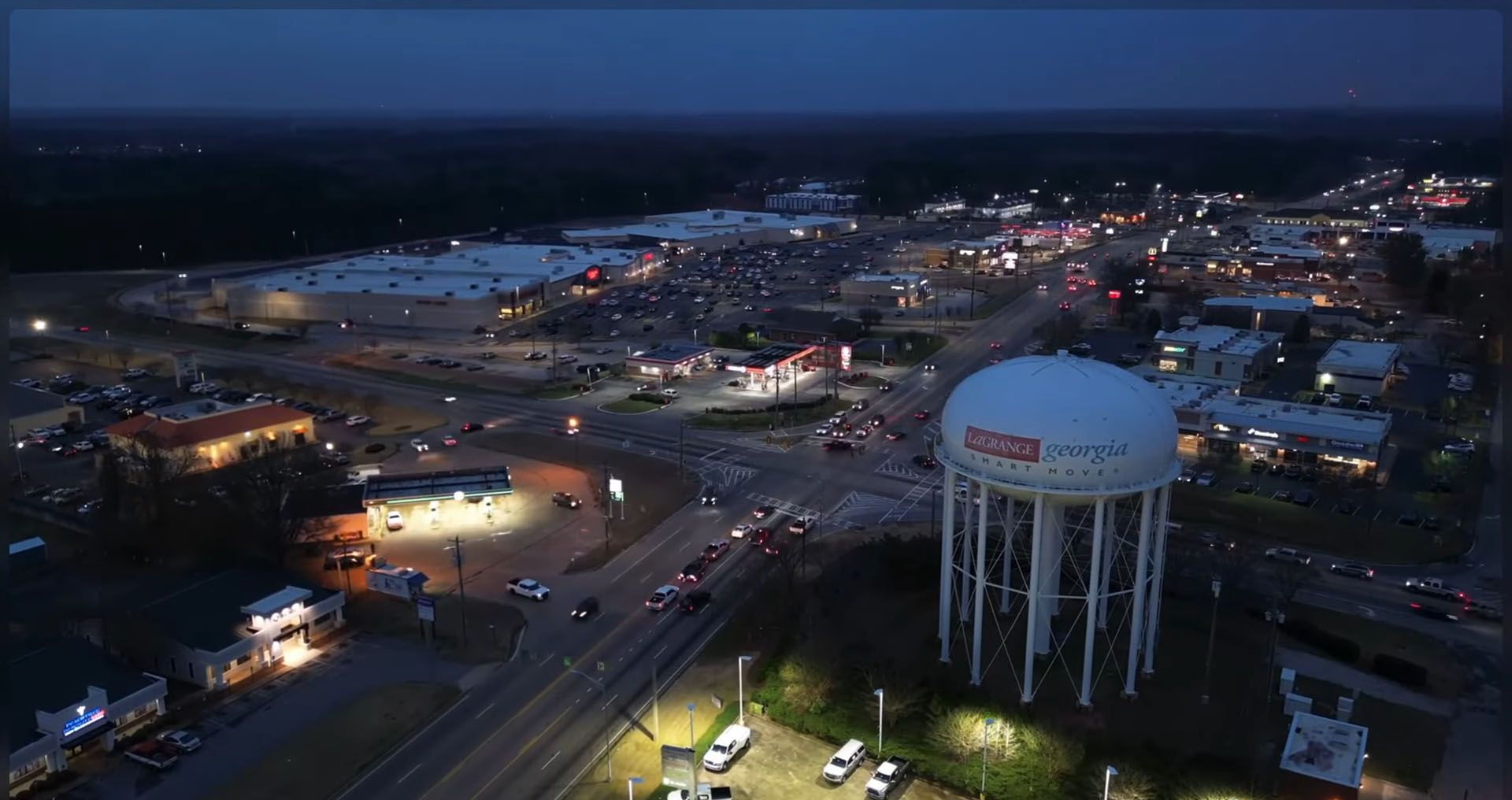
LaGrange, a city grappling with significant socio-economic challenges, reflects a stark reality where 21.9% of its population lives below the poverty line, according to Georgia Demographics.
This high level of poverty has a direct impact on crime rates, contributing to a violent crime rate of 6.64 per 1,000 residents and an overall crime rate of 50.83 per 1,000 residents.
- Population: 31,773
- Violent Crimes: 211
- Property Crimes: 1,404
- Total Crimes: 1,615
- Chances of Becoming a Victim: 1 in 151
High-risk areas within LaGrange, such as LaGrange Northeast and Whitfield, are especially vulnerable to these high crime rates.
These neighborhoods often suffer from the most severe economic deprivation, which can lead to a range of crimes, from petty thefts to more serious violent offenses.
Addressing the crime issues in LaGrange, particularly in high-risk areas like LaGrange Northeast and Whitfield, demands a multifaceted approach.
Economic development is critical and should include efforts to improve job opportunities through both attracting new businesses and supporting local entrepreneurship.
Man Hospitalized After Aggravated Assault in LaGrange
On October 5, 2024, LaGrange police responded to WellStar West Georgia Medical Center after a man arrived with multiple cuts from a physical altercation, as per LaGrange Daily News. The incident involved Lassandra Calloway, who allegedly attacked the man with a knife during a dispute.
The victim received medical treatment but was later released. Calloway has been charged with aggravated assault and family violence. Authorities are continuing the investigation and encourage anyone with information to contact the police.
5. Douglasville – 54.65 per 1000 people
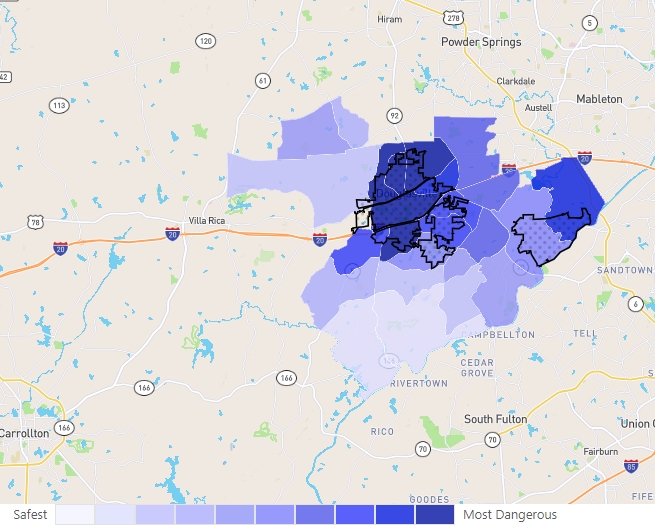
Douglasville is among the most dangerous cities in Georgia. With a population of 35,252 (according to Niche) reports a violent crime rate of 6.30 per 1,000 and a total crime rate of 54.65 per 1,000.
- Population: 35,252
- Violent Crimes: 239
- Property Crimes: 1,835
- Total Crimes: 2,074
- Chances of Becoming a Victim: 1 in 159
Neighborhoods such as Willows North and Burton Mill in Douglasville are particularly affected by these high crime rates.
Historical and economic challenges play a substantial role in this issue, as these areas have faced long-term neglect and economic decline, leading to deteriorated living conditions and limited economic opportunities.
Tackling the crime problems in Douglasville, especially in neighborhoods like Willows North and Burton Mill, requires addressing these historical and economic issues directly.
Revitalization efforts in these neighborhoods could include:
- Economic incentives for businesses to establish operations
- Improving infrastructure
- Enhancing local services
Emotional Trial Underway for Suspects in Douglasville Sweet 16 Shooting
In October 2024, the trial of three men accused of fatally shooting two teenagers at a Sweet 16 party in Douglasville, Georgia, began, bringing fresh waves of grief for the victims’ families, 11Alive reports.
The incident, which occurred in March 2023, left 15-year-old Samuel Moon and 14-year-old Ajanaye Hill dead. The accused—Tahkel Beverly-Smart, Kingston Cottman, and Timothy Coleman—are facing charges for their involvement in the tragic event.
4. Rome – 56.76 per 1000 People
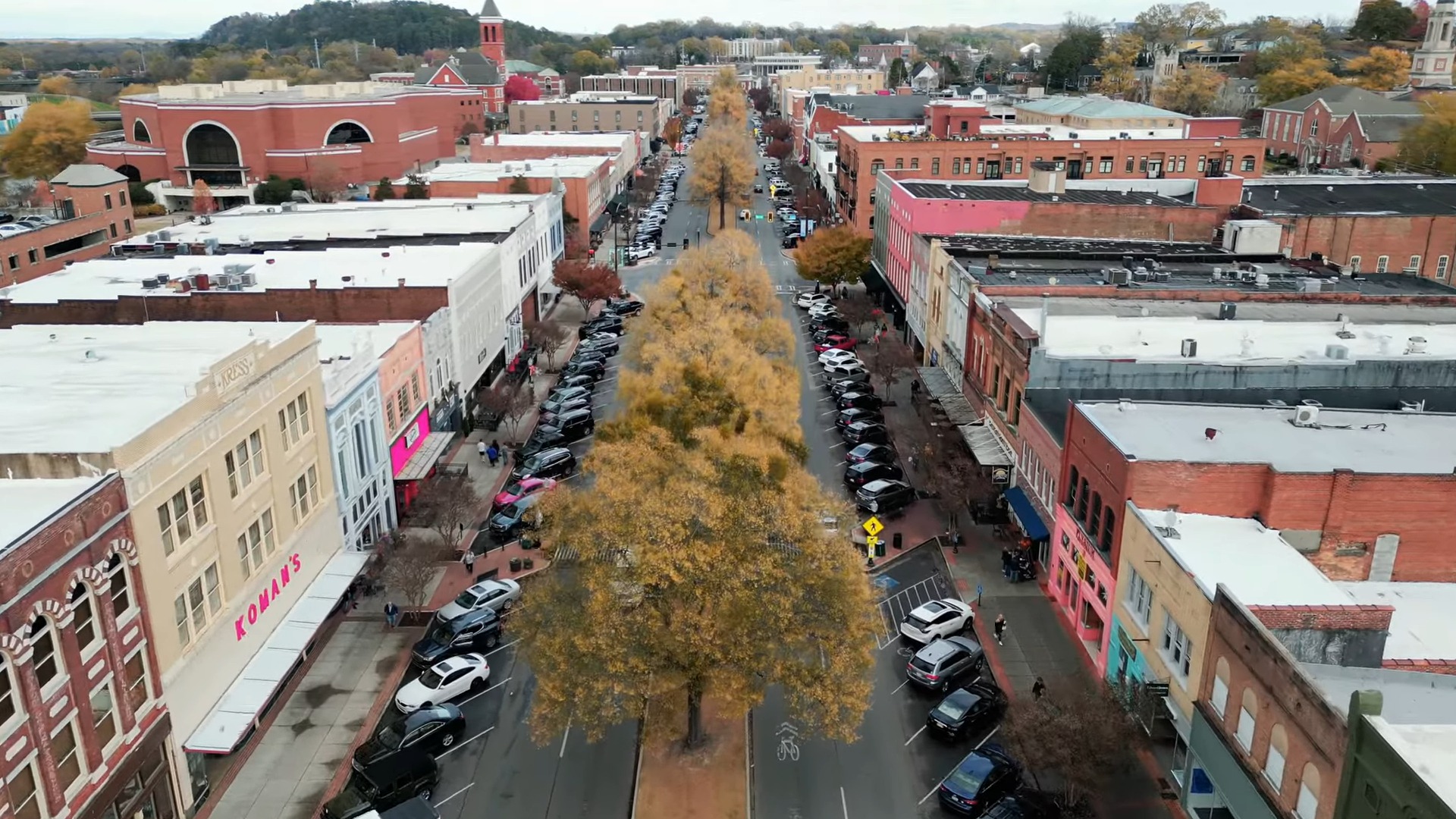
Rome’s historical significance contrasts with its current crime rates: 9.92 violent crimes per 1,000 residents and a total of 56.76 per 1,000.
- Population: 37,913
- Violent Crimes: 376
- Property Crimes: 1,776
- Total Crimes: 2,152
- Chances of Becoming a Victim: 1 in 101
Neighborhoods such as Shannon and Wax are particularly notorious for their high crime rates. Robberies have become quite common in the last few years. Economic stagnation has notably affected these areas, which in many cases leads to increased crime.
Economic stagnation can result from a variety of factors, including job scarcity, lack of investment in the area, and inadequate infrastructure, all of which contribute to an environment where crime can thrive.
Targeted interventions are necessary to address the issues in these high-crime neighborhoods.
Major Drug Bust in South Rome Leads to 39 Arrests and Seizure of 40 Firearms
In early October 2024, a significant law enforcement operation targeting drug-related crimes in South Rome, Georgia, resulted in 39 arrests and the seizure of 40 firearms, Cossa Valley News report. The joint operation, aimed at dismantling drug trafficking networks, uncovered large amounts of cocaine and dangerous drugs across several locations.
Among those arrested were individuals facing multiple charges, including possession of controlled substances, trafficking, and weapons violations. Authorities discovered several of the suspects had prior felony convictions and were in illegal possession of firearms during their crimes.
3. Milledgeville – 56.84 per 1000 People
Milledgeville Police Department finds body of man seen struggling in the water at Oconee Greenway https://t.co/zGkPlgYo5l
— 11Alive News (@11AliveNews) June 7, 2024
Milledgeville, grappling with a deeply entrenched economic crisis, presents alarming crime statistics that underscore the severity of its challenges. It is the third most dangerous city in the state.
With a poverty rate of 39.9%, according to the CityData, one of the highest in the region, Milledgeville reports a violent crime rate of 8.67 per 1,000 residents and an overall crime rate of 56.84 per 1,000.
- Population: 16,837
- Violent Crimes: 146
- Property Crimes: 811
- Total Crimes: 957
- Chances of Becoming a Victim: 1 in 115
Particularly affected areas like Burlington Park and Milledgeville Southeast are noteworthy for their high crime rates, which are exacerbated by the prevailing economic hardship.
The establishment of groups like neighborhood watch was an absolute must in this part of the state.
These neighborhoods suffer from:
- Lack of investment
- Insufficient employment opportunities
- Inadequate access to essential services
- Affordable housing
It could include attracting new businesses through economic incentives, developing public-private partnerships to enhance local infrastructure, and providing targeted support for small and medium-sized enterprises.
Increase in Drug-Related Arrests Following Major Investigation in Milledgeville
According to the Georgia Bureau of Investigation, in October 2024, authorities in Milledgeville, Georgia, have made significant strides in addressing drug-related crimes in the community.
A joint operation involving multiple law enforcement agencies, including the Georgia Bureau of Investigation (GBI), the Baldwin County Sheriff’s Office, and the Milledgeville Police Department, resulted in the arrest of ten individuals. This investigation, spanning four months, targeted drug trafficking and gang-related activities.
Those arrested face a range of serious charges, including drug trafficking and firearm offenses.
2. Forest Park – 57.94 per 1000 People
Forest Park, with a low median income of roughly $41,000, and a poverty rate of 18%, sees 9.12 violent crimes per 1,000 residents and a total crime rate of 57.94 per 1,000.
- Population: 19,400
- Violent Crimes: 177
- Property Crimes: 947
- Total Crimes: 1,124
- Chances of Becoming a Victim: 1 in 110
In Forest Park, areas such as Downtown and Mountain View Plaza are notably affected by high crime rates, a situation largely attributed to the economic challenges these neighborhoods face.
In 2018, 1 in 3 houses had income lower than the poverty line according to the report issued by Georgian DCA. Things have gotten somewhat better recently.
These regions are marked by low median incomes and elevated poverty levels, conditions that inevitably fuel a range of criminal activities from minor thefts to more aggressive violent acts, Fox5Atlanta reports.
Simultaneously, there’s a pressing need to bolster the local educational systems and community services.
Programs that focus on skill development, financial literacy, and vocational training can empower residents and provide alternatives to criminal activities.
Health and social services can also play a vital role in supporting struggling families and at-risk youth, thereby preventing the desperation that often leads to crime.
Forest Park Shooting Spree Leaves One Dead, Two Injured, Suspect in Custody
11Alive reports that, in early October 2024, a violent crime spree in Forest Park, Georgia, resulted in one death and two injuries. The suspect, 33-year-old Victor Demetrious Baymon, was arrested after a chase that ended with him crashing a stolen vehicle in Cobb County.
The series of incidents began when Baymon allegedly followed his ex-girlfriend to a tax preparation office, where he fatally shot a tax preparer and injured another individual. He then proceeded to carjack two separate vehicles, with one of these carjackings leading to the random shooting of a construction worker.
The shootings triggered a citywide lockdown in Forest Park, which lasted for several hours before the suspect was finally apprehended. Flock cameras had helped track his movements, leading to a police chase. Baymon is now facing multiple charges, including malice murder, aggravated assault, and carjacking, and is currently hospitalized due to injuries sustained during the crash.
1. College Park – 87.90 per 1000 People
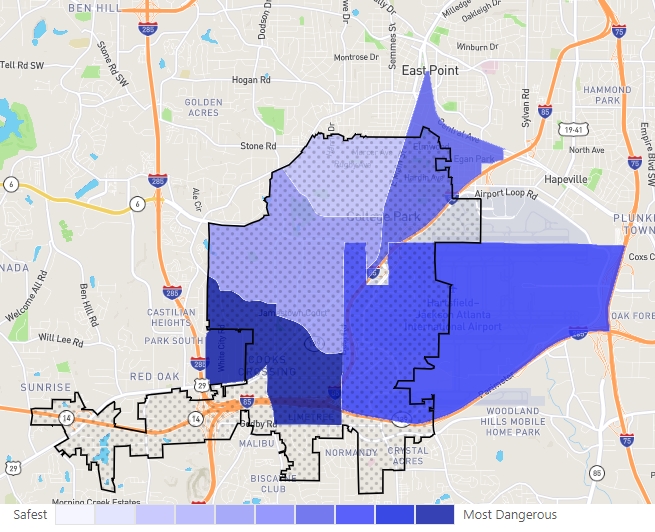
College Park faces a dire socio-economic landscape characterized by extreme poverty and significant income inequality. The combination of those factors makes it top the list of the most dangerous cities in Georgia.
These factors contribute to a starkly high violent crime rate of 15.67 per 1000 residents and an even more troubling total crime rate of 87.90 per 1000 according to the NeighborhoodScout.
- Population: 13,914
- Violent Crimes: 218
- Property Crimes: 1,005
- Total Crimes: 1,223
- Chances of Becoming a Victim: 1 in 64
Neighborhoods such as Jamestown Court and College Park South are infamous for their high crime rates.
These areas are often the hardest hit by economic struggles, where job opportunities are scarce, educational resources are limited, and community services are often inadequate.
Recently there was an issue with a lithium battery plant that locals refuse to allow, as per Fox5Atlanta.
Such conditions foster an environment where crime can thrive, from petty thefts to more serious violent offenses.
Economic development initiatives are vital and should focus on job creation, perhaps through attracting new businesses with tax incentives and supporting local entrepreneurship with grants and training programs.
For all these reasons, it is one of the worst places to live in Georgia.
Officer-Involved Shooting at College Park MARTA Station Under Investigation
Georgia Bureau of Investigation reported that, in early October 2024, a fatal officer-involved shooting took place at the College Park MARTA station. On the evening of October 6, a man was seen brandishing a firearm and pointing it at another individual.
A MARTA police officer confronted the armed man, issuing verbal commands. However, the suspect reportedly turned toward the officer while reaching for his weapon, prompting the officer to fire. The man was struck and later pronounced dead at a nearby hospital. The Georgia Bureau of Investigation (GBI) is currently investigating the incident to determine the exact circumstances.
Common Factors Contributing to High Crime Rates
The most dangerous cities in Georgia with high crime rates often share several underlying factors that contribute to their status. Understanding these factors is essential for addressing and mitigating crime effectively.
Here are some expanded explanations of the common contributing factors:
Poverty and Unemployment
Poverty and unemployment are primary drivers of crime.
High unemployment rates mean fewer legal opportunities for people to earn a living, which can push individuals towards criminal activities as an alternative means of survival.
Poverty exacerbates this situation by limiting access to essential services such as education, healthcare, and housing, which are crucial for overall social stability.
Income Inequality
Income inequality often goes hand in hand with poverty but refers specifically to the large income gap between the wealthiest and the poorest in society.
This disparity can lead to feelings of disenfranchisement and frustration among those on the lower end of the economic spectrum.
When a significant portion of the population feels marginalized, it can result in higher rates of crime, including theft, burglary, and even violent crimes as expressions of anger and desperation.
Gang Activity
Gang activity significantly contributes to crime rates, particularly in urban areas. For instance, a large chunk of Atlanta crime rate comes from this. According to justice.gov, there are roughly 58 gangs in the metropolitan area, with almost 2000 members.
That alone makes it one of the most dangerous cities in Georgia.
Gangs often provide a sense of belonging and identity to their members, especially in communities where other social structures are lacking.
They are involved in various criminal activities, including drug trafficking, extortion, and violent crimes, which destabilize communities.
Drug-Related Crimes
Drug-related crimes are a major issue in cities with high crime rates.
Just a couple of months ago, we could see a major drug crackdown in Atlanta.
The drug trade can be incredibly lucrative, and in areas with limited economic opportunities, it can seem like one of the few viable ways to make money.
This trade often brings with it violent crime, property crime, and a host of social issues that further degrade the community fabric.
Insufficient Law Enforcement Resources
Many cities struggling with high crime rates also face challenges related to law enforcement. Insufficient resources have played a role in making Atlanta one of the most dangerous cities in Georgia.
Insufficient funding for police forces, lack of modern equipment, and inadequate training can prevent law enforcement agencies from effectively tackling crime. The local police department has a problem with hiring officers.
The inadequacy can lead to a cycle where criminals feel emboldened due to the low risk of apprehension, further increasing crime rates.
Methodology
For analysis of Georgia crime rate, I rely on the crime data annually published by different sources like NeighborhoodScout and AreaVibes, which use data collected from government sources.
This data is released in two key segments: a preliminary overview focused on the nation’s largest cities, followed by a detailed year-end report.
- Per Capita Violent Crime Rates
- Per Capita Property Crime Rates
In pursuing a nuanced examination, our study predominantly concentrated on the state of Georgia to get a more rounded state-wide perspective.
FAQs
To stay safe in high-crime areas, people are advised to:
- Stay aware of their surroundings.
- Avoid walking alone at night.
- Lock doors and secure valuables.
- Use well-lit, populated areas when traveling.
- Trust their instincts and avoid risky situations.
The Bottom Line
The cities profiled represent the most challenging areas in terms of safety in Georgia for 2025.
While they contribute to the state’s rich and diverse character, these high crime rates highlight the need for concerted efforts to improve safety.
The ongoing initiatives and community engagement are crucial, but much remains to be done to ensure these cities can balance their cultural and historical significance with the well-being of their residents.
References
- DataUSA – Statesboro, GA Population
- Georgia Southern University – Statesboro, GA Data Set
- Research Gate – Crime and Residential Choice: A Neighborhood Level Analysis of the Impact of Crime on Housing Prices
- Grice Connect – Tragic shooting in Statesboro leaves father dead, son in custody
- AreaVibes – Most dangerous cities in Georgia
- U.S. Bureau of Labor Statistics – Economy at Glance: Hinesville-Fort Stewart, GA
- The Georgia Sun – Sunday Night Shooting Injures 1 in Hinesville
- World Population Review – Warner Robins, Georgia Population 2024
- 13WMAZ – Police investigate after fatal shooting in Warner Robins, suspect at large
- Axios – Violent crime in Atlanta dropped
- AECF – A Profile of Youth and Young Adults in Atlanta
- APNews – Gunman wounds 3 in Atlanta food court before being shot by officer, police say
- 11Alive – Shooting at condominium complex was a ‘justifiable homicide,’ APD says
- Georgia Demographics – Is LaGrange the best Georgia city for your business?
- LaGrange Daily News – Man sent to hospital with cuts after aggravated assault
- Niche – Douglasville Niche Grade
- ScienceDirect – Does higher unemployment lead to greater criminality?
- Coosa Valley News – Joint Operation Results in 39 arrests, 40 guns seized in South Rome Drug Hotspots
- City-Data – Milledgeville, Georgia (GA) Poverty Rate Data
- Georgia Bureau of Investigation – GBI Arrests 10 in Joint Drug Investigation in Milledgeville
- Fox5Atlanta – Victim in fatal triple shooting in Forest Park identified, suspect arrested
Related Posts:
- What Are the Main Goals of the Human and Civil…
- 10 Most Dangerous Cities in Texas in 2025 You Should…
- Most Dangerous Cities in Michigan in 2025 - 10…
- Most Dangerous Cities in Ohio - Top 10 Risky Areas…
- 10 Most Dangerous Cities in Florida in 2025 to Watch Out For
- Most Dangerous Cities in Mexico 2025 - Top 10 Places…








